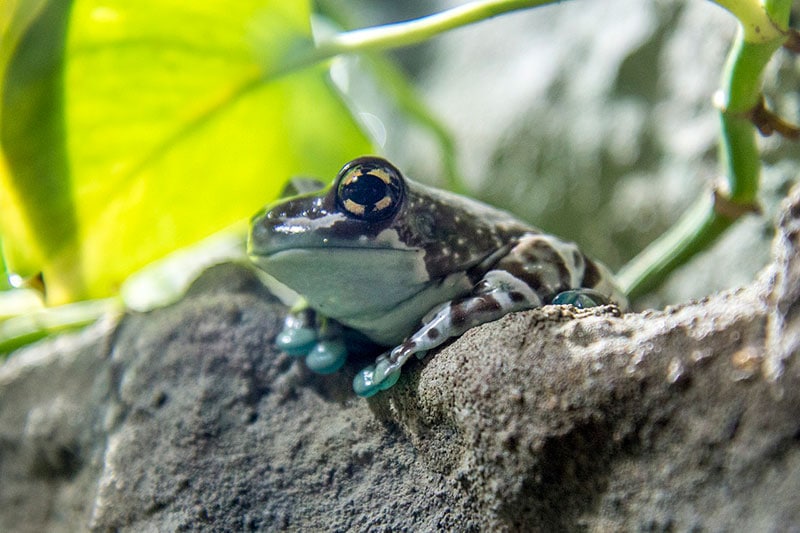Do Frogs Feel Pain? Vet-Reviewed Facts & FAQ
Updated on

Let’s begin by changing the question, “Do frogs feel pain?” to, “Do frogs experience pain?” When we frame it this way, the answer becomes simple: It’s a resounding yes, frogs do feel pain.
Nearly all animals possess pain receptors.1 In fact, the nervous systems of all vertebrates are organized in fundamentally the same way, and even some invertebrates have such systems, like certain species of mollusks.
However, the extent to which they feel and respond to pain varies between each living organism. For example, frogs have the neuroanatomy necessary to perceive pain, but their experience of pain may differ from that of mammals. Also, since animals can’t express their distress verbally, it can be difficult to know whether they are feeling pain and how intensely.
Here, we discuss the capacity of frogs to sense pain, so you can be better equipped to ensure the well-being of your little amphibian friend.
What Is Pain?
The National Institutes of Health defines pain as an “unpleasant signal that something hurts.2 It is a complex experience that differs greatly from person to person.” Pain may manifest as mild or explosive sensations, such as tingling, tingling, tingling, burning, shooting, or aching.
This definition applies to humans, but what about animals?

How Do Animals Experience Pain?
The nervous systems of all vertebrates are organized in essentially the same way. Indeed, reptiles, amphibians, and fish have the neuroanatomy necessary to perceive pain.
- Pain receptor cells (called nociceptors) in appropriate places in the body
- Central neural pathways with neurotransmitters
- Adequate brain analyzers
- An output system to initiate a behavioral response
The way that animals react to pain (their behavioral response) varies depending on the species. For instance, consider a predator-prey relationship: a lion chasing an antelope in the African savannahs. If the antelope gets injured by the lion, it may be unlikely to vocalize its pain so as to avoid attracting more predators.
Thus, the absence of a behavioral response to pain (in the example, the absence of vocalizations) does not mean the antelope doesn’t feel pain, but rather that its lack of reaction is an adaptive response to ensure its survival. The same goes for predators, like lions, where showing pain or weakness could make them vulnerable to their rivals.
But the experience of pain is not limited to mammals. Take carp, for example. Researchers tested the response of carp to painful stimuli by hooking them with bait.3 The carp likely felt pain because they adopted avoidance behavior afterward: They avoided biting the bait again for several weeks after the experiment. Reptiles also adopt this avoidance behavior in response to certain harmful stimuli. The researchers discovered that if they gave the reptiles pain-killing drugs, the reptiles wouldn’t try as much to avoid painful stimuli, meaning they likely did feel some level of pain in the first place.

How Do Frogs Express Pain?
Experiments have shown that when frogs are exposed to painful stimuli, they exhibit behaviors consistent with distress. For instance, frogs subjected to electric shocks or exposure to harmful chemicals will often attempt to escape, vocalize, or display altered physiological responses.
In a study, researchers established four basic behavioral responses to pain in non-mammalian vertebrates (i.e., amphibians, fish, reptiles, and birds):
- Rapid startle reaction (such as trying to escape)
- Nonspecific fight response (such as trying to bite the source of pain)
- Affective response (such as increased vocalizations)
- Coordinated response (such as rubbing or scratching the area where they experienced the painful stimulus)
A sick frog is also likely to be in pain, hence the need to be attentive to signs of underlying health issues like:
- Lack of appetite
- Inability to catch prey
- Changes to skin
- Inability to defecate
- Inability to jump
How to Make Sure Your Frog Is Healthy and Pain Free
The truth is that interpreting pain is trickier with non-mammals like frogs. But since we know that they have neural pathways to perceive pain, it’s important to do everything in your power to prevent possible suffering in your pet.
Your veterinarian also relies on you to report behavioral changes that may indicate painful conditions. Therefore, you have an important role to play in ensuring that your frog does not suffer unnecessarily.
The key here is to become an expert at detecting the slightest signs of pain in your pet frog, such as a sudden loss of appetite, difficulty jumping, or a change in their vocalizations.
Apart from this, you should avoid excessive handling of your frog or at least only do it with extreme delicacy and care. Their skin is fragile and sensitive.

FAQ
How Do Frogs React to Injuries?
Frogs have developed various defensive mechanisms to respond to potential threats or harm. When injured or exposed to harmful stimuli, they often exhibit behaviors like jumping, fleeing, or vocalizing.
Are There Ethical Considerations for Using Frogs in Research?
Using frogs in scientific research must always be done with care and consideration for their well-being. This is why researchers are required to follow strict ethical guidelines—such as the PHS Policy—to minimize pain and stress during experiments.
Final Thoughts
Although frogs may not feel pain in the same way that we do, evidence shows that these tiny amphibians are indeed capable of perceiving and responding to painful stimuli. In fact, the presence of pain receptors and neural pathways similar to those in mammals indicate that frogs are biologically equipped to experience pain.
That said, their experience of suffering and pain likely differs from that observed in mammals, though it is impossible to be sure.
Regardless of how these creatures feel pain, what truly matters is treating frogs with the same respect, compassion, and kindness as any living thing.
Featured Image Credit: Jay Ondreicka, Shutterstock












